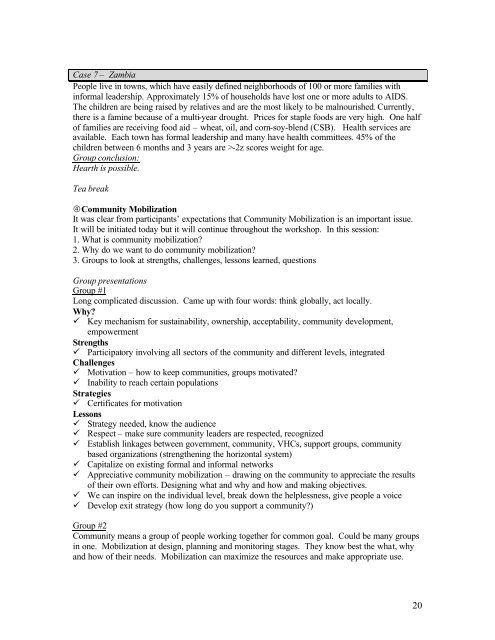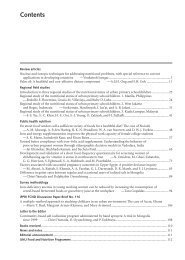Training of Trainers Workshop: Positive Deviance and Hearth
Training of Trainers Workshop: Positive Deviance and Hearth
Training of Trainers Workshop: Positive Deviance and Hearth
Create successful ePaper yourself
Turn your PDF publications into a flip-book with our unique Google optimized e-Paper software.
Case 7 – Zambia<br />
People live in towns, which have easily defined neighborhoods <strong>of</strong> 100 or more families with<br />
informal leadership. Approximately 15% <strong>of</strong> households have lost one or more adults to AIDS.<br />
The children are being raised by relatives <strong>and</strong> are the most likely to be malnourished. Currently,<br />
there is a famine because <strong>of</strong> a multi-year drought. Prices for staple foods are very high. One half<br />
<strong>of</strong> families are receiving food aid – wheat, oil, <strong>and</strong> corn-soy-blend (CSB). Health services are<br />
available. Each town has formal leadership <strong>and</strong> many have health committees. 45% <strong>of</strong> the<br />
children between 6 months <strong>and</strong> 3 years are >-2z scores weight for age.<br />
Group conclusion:<br />
<strong>Hearth</strong> is possible.<br />
Tea break<br />
„Community Mobilization<br />
It was clear from participants’ expectations that Community Mobilization is an important issue.<br />
It will be initiated today but it will continue throughout the workshop. In this session:<br />
1. What is community mobilization?<br />
2. Why do we want to do community mobilization?<br />
3. Groups to look at strengths, challenges, lessons learned, questions<br />
Group presentations<br />
Group #1<br />
Long complicated discussion. Came up with four words: think globally, act locally.<br />
Why?<br />
ü Key mechanism for sustainability, ownership, acceptability, community development,<br />
empowerment<br />
Strengths<br />
ü Participatory involving all sectors <strong>of</strong> the community <strong>and</strong> different levels, integrated<br />
Challenges<br />
ü Motivation – how to keep communities, groups motivated?<br />
ü Inability to reach certain populations<br />
Strategies<br />
ü Certificates for motivation<br />
Lessons<br />
ü Strategy needed, know the audience<br />
ü Respect – make sure community leaders are respected, recognized<br />
ü Establish linkages between government, community, VHCs, support groups, community<br />
based organizations (strengthening the horizontal system)<br />
ü Capitalize on existing formal <strong>and</strong> informal networks<br />
ü Appreciative community mobilization – drawing on the community to appreciate the results<br />
<strong>of</strong> their own efforts. Designing what <strong>and</strong> why <strong>and</strong> how <strong>and</strong> making objectives.<br />
ü We can inspire on the individual level, break down the helplessness, give people a voice<br />
ü Develop exit strategy (how long do you support a community?)<br />
Group #2<br />
Community means a group <strong>of</strong> people working together for common goal. Could be many groups<br />
in one. Mobilization at design, planning <strong>and</strong> monitoring stages. They know best the what, why<br />
<strong>and</strong> how <strong>of</strong> their needs. Mobilization can maximize the resources <strong>and</strong> make appropriate use.<br />
20

















